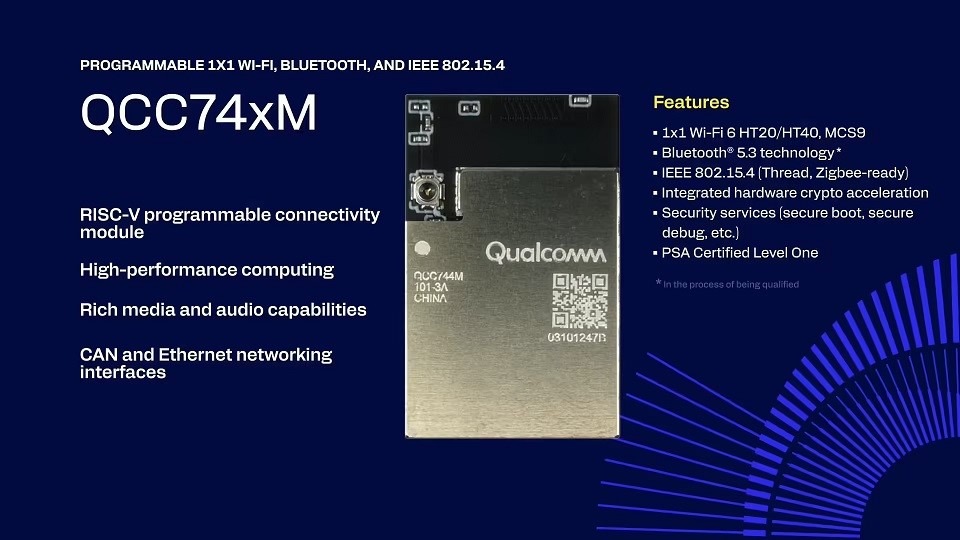In the rapid evolution of the Internet of Things (IoT), Qualcomm's latest initiatives once again demonstrate its leadership in technological innovation and market insight. On November 12, 2024, Qualcomm announced the launch of two new connectivity modules, the QCC74xM and the QCC730M, which are expected to be available in the first half of 2025. Among them, the QCC74xM module is particularly eye-catching, as it is Qualcomm's first programmable connectivity module with RISC-V architecture, which not only demonstrates Qualcomm's support for open standards, but also indicates the huge potential of RISC-V architecture in the IoT field.
1. The rise of the RISC-V architecture
The open-source and royalty-free model of the RISC-V architecture provides greater flexibility and cost-effectiveness for IoT device manufacturers. The flexibility and cost-effectiveness of this architecture make RISC-V a place in IoT applications such as smart homes, smart wearables, and smart cities. In fact, the global shipment of RISC-V chips has exceeded 10 billion, of which Chinese manufacturers have contributed 5 billion, accounting for more than 50%, which fully demonstrates the hot land and rapid development trend of RISC-V architecture chip innovation.
2. Wi-Fi 6
The QCC74xM module supports Wi-Fi 6 1T1R 40MHz, which gives the module a significant advantage in wireless connectivity performance. Wi-Fi 6 technology is favored by the market for its higher data transmission rate, larger number of concurrent users, lower latency, and better energy-saving features. In the smart home environment, the cooperation of multiple devices puts forward higher requirements for network performance, and the support of Wi-Fi 6 technology enables the QCC74xM module to meet these requirements.

Figure: Qualcomm announced the QCC74xM, the first programmable connectivity module with RISC-V architecture
1. Convergence of multimedia functions
The QCC74xM module not only excels in wireless connectivity technology, but also has rich multimedia functions. The module supports CAN and Ethernet interfaces, is compatible with IEEE 802.15.4 (the bottom layer of Zigbee) in terms of wireless protocols, and Bluetooth 5.3 certification is also in the process. The integration of these functions makes the QCC74xM module suitable for smart home central control screens, gateways, smart locks, IP cameras and other applications.
2. The importance of micropower design
The micropower design of the QCC730M module is designed for low-power IoT applications such as IP cameras, smart locks, and sensors. The built-in 60MHz MCU and integrated 640kB SRAM and 1.5MB of non-volatile RRAM memory provide these devices with enough computing power and storage while maintaining low power consumption. This is especially important for extending the life of battery-powered devices.
3. Impact of the IoT market
Qualcomm's two new modules not only demonstrate its technical strength in the IoT market, but also reflect the market demand for high-performance, low-power, multi-protocol supported IoT solutions. With the continuous development of the smart home and smart home appliance market, these two modules are expected to be an important force driving the market growth. According to IDC data, the market size of China's smart home industry will exceed 710 billion yuan in 2023, and this huge market provides a broad application space for Qualcomm's new products.
4. Editor's point of view
Editors of China Exportsemi believes that Qualcomm's two new modules will have a profound impact on the IoT market. The adoption of the RISC-V architecture is likely to drive more open standards in the IoT domain, while the support of Wi-Fi 6 technology provides higher network performance for devices. The importance of micropower design should not be overlooked, as it will make IoT devices more environmentally friendly and economical. In general, Qualcomm's two modules are not only technologically advanced, but also have precise market positioning, which is expected to become a new benchmark in the IoT field. As the global smart home market continues to grow, Qualcomm's two modules are expected to promote the popularization and application of IoT technology on a global scale, bringing users a richer and more convenient smart life experience.
5. Conclusion
The launch of Qualcomm's QCC74xM and QCC730M modules is an important milestone in the IoT space. The adoption of the RISC-V architecture, support for Wi-Fi 6 technology, and micropower design all demonstrate Qualcomm's deep understanding of the future development of the IoT market. These two modules are expected to further drive the development of the smart home and smart home appliance market, bringing smarter, more efficient, and more energy-efficient IoT solutions to consumers.






